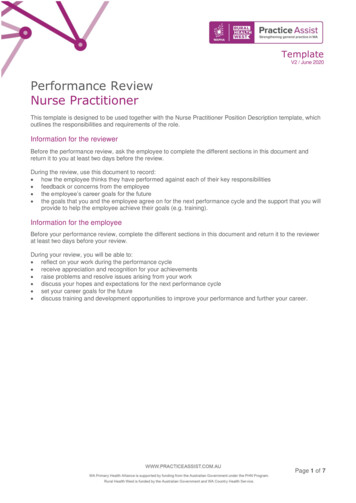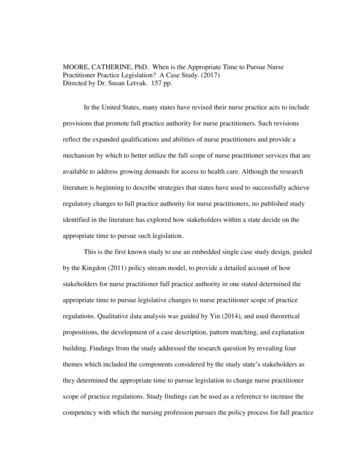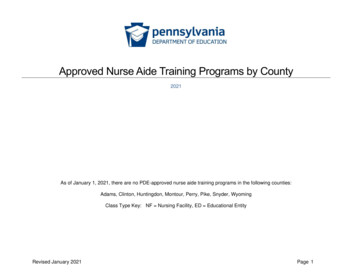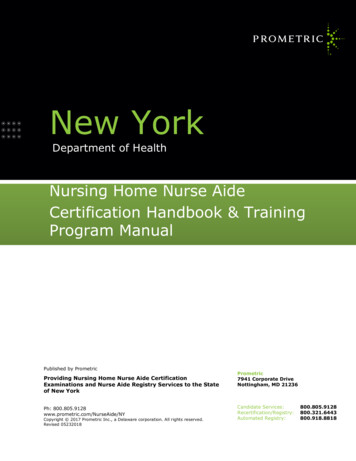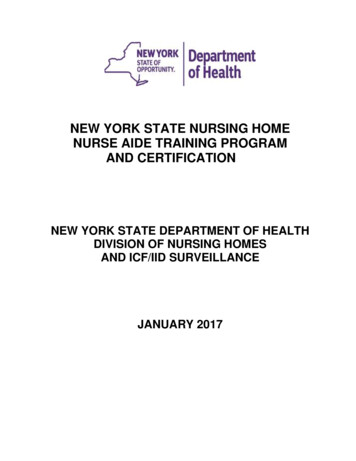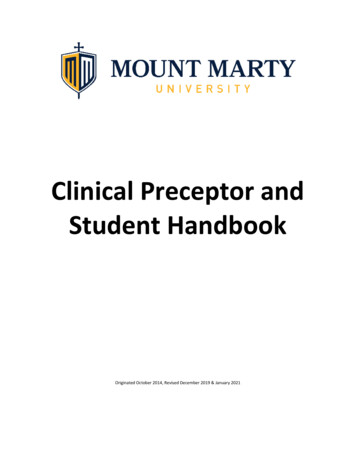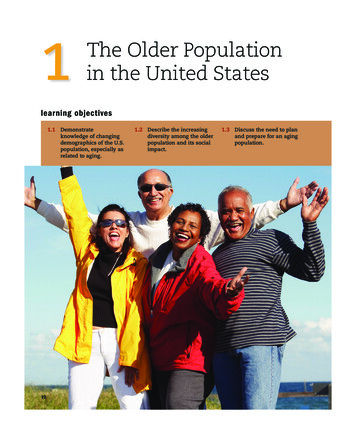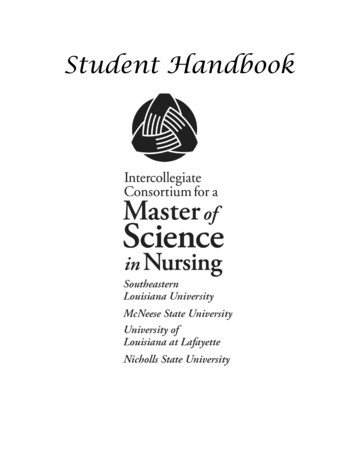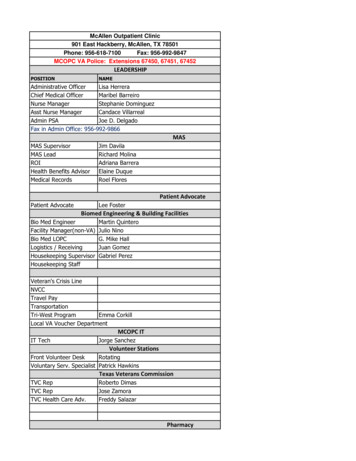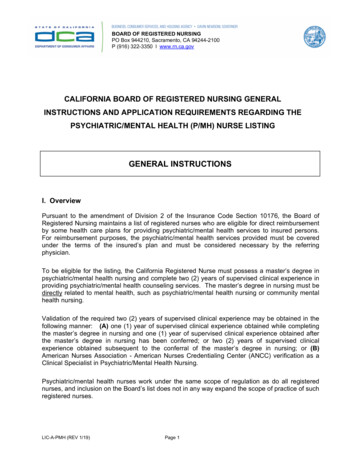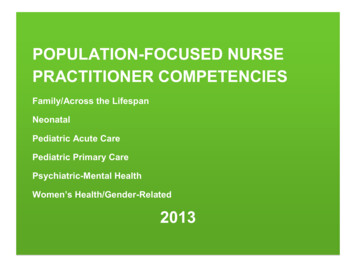
Transcription
POPULATION-FOCUSED NURSEPRACTITIONER COMPETENCIESFamily/Across the LifespanNeonatalPediatric Acute CarePediatric Primary CarePsychiatric-Mental HealthWomen’s Health/Gender-Related2013
Population-Focused Competencies Task Force2013
Population-Focused Competencies Task ForceTask Force ChairAnne Thomas, PhD, ANP-BC, GNP, FAANPNational Organization of Nurse Practitioner FacultiesTask Force MembersRobin Bissinger, PhD, APRN, NNP-BCNational Certification CorporationNNP Work GroupMargaret Brackley, PhD, RN, FAAN, FAANPNational Organization of Nurse Practitioner FacultiesPMHNP Work GroupBill Buron, PhD, RN, FNP/GNP-BCAmerican Academy of Nursing Gero-Psych ProjectFNP Work GroupRenee Davis, MSN, RN, CPNPAmerican Association of Colleges of NursingPCPNP Work GroupKathleen R. Delaney, PhD, PMH-NPAmerican Association of Colleges of NursingPMHNP Work GroupEvelyn Duffy, DNP, G/ANP-BC, FAANPGerontological Advanced Practice Nurses AssociationFNP Work GroupDeb Gayer, PhD, RN, CPNP-PCPediatric Nursing Certification BoardPCPNP Work GroupCaroline Hewitt, DNS(c), WHNP-BC, ANP-BCNational Certification CorporationWHNP Work GroupSusan Hoffstetter, PhD, WHNP-BC, FAANPNational Association of Nurse Practitioners in Women’s HealthFNP Work GroupJudy Honig, EdD, DNPNational Organization of Nurse Practitioner FacultiesPCPNP Work GroupJean Ivey, DSN, CRNP, PNP-PCAssociation of Faculties of PNPsPCPNP Work GroupTess Judge-Ellis, DNP, ARNPNational Organization of Nurse Practitioner FacultiesFNP Work GroupRebecca Koeniger-Donahue, PhD, APRN-BC, WHNP-BC, FAANPAmerican Association of Colleges of NursingWHNP Work GroupJudy LeFlore, PhD, RN, NNP-BC, CPNP-PC&AC, ANEF, FAANNational Organization of Nurse Practitioner FacultiesACPNP Work GroupCathy Haut, DNP, CPNP, CCRNAmerican Association of Colleges of NursingACPNP Work Group3Population-Focused Nurse Practitioner Competencies
Nancy Magnuson, DSN, CS, FNP-BCAmerican Association of Colleges of NursingFNP Work GroupDebra Sansoucie, EdD, ARNP, NNP-BCNational Association of Neonatal Nurse PractitionersNNP Work GroupJulie Marfell, DNP, FNP-BC, FAANPNational Organization of Nurse Practitioner FacultiesFNP Work GroupCarol Savrin, CPNP, FNP, BC, FAANPAssociation of Faculties of PNPsFNP Work GroupKathleen McCoy, DNSc PMHNP/BC, PMHCNS-BC, FNP-BC FAANPAmerican Nurses Credentialing CenterPMHNP Work GroupMargaret Scharf, DNP, PMHCNS-BC, FNP-BCInternational Society of Psychiatric NursingPMHNP Work GroupKaren Melillo, PhD, ANP-C, FAANP, FGSAAmerican Academy of Nursing Gero-Psychiatric ProjectWHNP Work GroupLorna Schumann, PhD, NP-C, ACNP, BC, ACNS, BC, CCRN-R, FAANPAmerican Association of Nurse Practitioners Certification ProgramFNP Work GroupJulie Miller, MSN, APRN, PNP-BC, FNPAmerican Nurses Credentialing CenterPCPNP Work GroupDiane Seibert, PhD, ARNP, FAANPNational Organization of Nurse Practitioner FacultiesWHNP Work GroupJamille Nagtalon-Ramos, MSN, CRNPNational Association of Nurse Practitioners in Women’s HealthWHNP Work GroupDiane Snow, PhD, RN, PMHNP-BC, CARN, FAANPNational Organization of Nurse Practitioner FacultiesPMHNP Work GroupCarol Patton, DrPH, RN, FNP-BC, CRNP, CNEAmerican Nurses Credentialing CenterFNP Work GroupJoan Stanley, PhD, CRNP, FAAN, FAANPAmerican Association of Colleges of NursingFNP, NNP, ACPNP, PCPNP, PMHNP, WHNP Work GroupsKarin Reuter-Rice, PhD, CPNP-AC, CCRN, FCCMPediatric Nursing Certification BoardACPNP Work GroupJudy Verger, RN, PhDAssociation of Faculties of PNPsACPNP Work GroupLori Baas Rubarth, PhD, APRN-NP, NNP-BCAmerican Association of Colleges of NursingNNP Work GroupMary Weber, PhD, PMHNP-BCAmerican Psychiatric Nurses AssociationPMHNP Work Group4Population-Focused Nurse Practitioner Competencies
POPULATION-FOCUSED NURSE PRACTITIONER COMPETENCIES:Family/Across the Lifespan, Neonatal, Acute Care Pediatric, Primary CarePediatric, Psychiatric-Mental Health, & Women’s Health/Gender-RelatedIntroductionSince the release of the 2008 APRN Consensus Model: Licensure, Accreditation, Certification, and Education, thenurse practitioner (NP) community has been undertaking efforts to ensure congruence with the model. Withineducation, NP programs have focused on changes to align educational tracks with the NP populations delineatedin the model. National organizations have supported these efforts through collaborative work on the NPcompetencies that guide curriculum development. The first initiatives focused on the development of adultgerontology competencies (2010 and 2012). In 2011, a multi-organizational task force embarked on the challengeto identify current competencies for the remaining NP population foci. This document presents the entry intopractice competencies for the Family/Across the Lifespan, Neonatal, Pediatric Acute Care, Pediatric PrimaryCare, Psychiatric-Mental Health, and Women’s Health/Gender-Related nurse practitioners. These competenciesexplicate the unique characteristics and role of each population foci and are designed to augment the NP corecompetencies.BackgroundThe National Organization of Nurse Practitioner Faculties (NONPF) released the first set of core competencies forall nurse practitioners in 1990 and subsequently has revised them in 1995, 2000, 2002, 2006, 2011, and 2012.Recognizing the need to give NP programs further guidance in an area of focus, NONPF, in collaboration with theAmerican Association of Colleges of Nursing (AACN), facilitated the development of the first sets of populationspecific competencies. In 2002, a national panel completed the work to identify competencies in the NP primarycare areas of Adult, Family, Gerontological, Pediatric, and Women’s Health. In 2003, work groups released theAcute Care Nurse Practitioner Competencies and the Psychiatric-Mental Health Nurse PractitionerCompetencies. The development of these population-focused competencies involved a national, consensusprocess that remains in place today and was used with the 2012 population-focused competencies.The APRN Consensus Model made a few changes to the population foci for NP educational tracks. Notably, theadult and gerontology foci were merged, and both the adult-gerontology and pediatric foci are distinguished as5Population-Focused Nurse Practitioner Competencies
being primary care or acute care. In addition, the Consensus Model stipulates that the Psychiatric-Mental Healthfocus crosses the lifespan. Competencies specific to these newly defined population foci did not exist. In 2011with funding from The John A. Hartford Foundation, AACN, in collaboration with NONPF, delineated the adultgerontology competencies in primary care and acute care. Recognizing the need for competencies that align witheach population foci in the Model, NONPF convened a national task force in 2011 to review previous work anddelineate updated entry-level competencies for the remaining population foci.The task force includes representatives of various organizations from nursing education and certification. The taskforce formed sub-groups to identify the competencies for each population focus and also convened periodically asa whole for discussion. The sub groups included representatives from the stakeholder organizations thatcorresponded with the focus area. The task force invited review of the competencies in an external validationprocess, and the final competencies reflect the feedback obtained in this step.The APRN CoreThe APRN Consensus Model stipulates that an APRN education program must include at a minimum threeseparate comprehensive graduate-level courses known as the APRN core. The APRN core consists of: advancedphysiology/pathophysiology, including general principles that apply across the lifespan; advanced healthassessment, which includes assessment of all human systems, advanced assessment techniques, concepts andapproaches; and advanced pharmacology, which includes pharmacodynamics, pharmacokinetics andpharmacotherapeutics of all broad categories of agents. In addition to the broad-based content described above,the work groups chose to suggest content within the population-focused competencies related to the three corecourses as it pertained to the specific population. This was done to illustrate the differences in application of thebroad-based core courses as it related to therapeutic management of the various populations.The Relationship of the NP Core and Population-Focused CompetenciesEach entry-level NP is expected to meet both the NP core competencies and the population-focusedcompetencies in the area of educational preparation. Accordingly, NP educational programs use both NP corecompetencies and population-focused competencies to guide curriculum development.At the time the task force began its work, NONPF had just released a new set of core competencies for NPs. Thisnew set represented NONPF’s endorsement of the transition of NP education to the doctoral level and anintegration of previous Master’s-level core competencies with the practice doctorate NP competencies released6Population-Focused Nurse Practitioner Competencies
by NONPF in 2006. The NONPF Board had charged a task force to integrate the two documents with the goal ofhaving one set of NP core competencies to guide educational programs preparing NPs to implement the fullscope of practice as a licensed independent practitioner.The new core competencies moved away from the previous 7 domains as a framework and instead used ninecore competency areas that delineate the essential behaviors of all NPs. These are demonstrated upongraduation regardless of the population focus of the program. The competencies are necessary for NPs to meetthe complex challenges of translating rapidly expanding knowledge into practice and function in a changing healthcare environment. The new, nine competency areas also provide the framework for the population-focusedcompetencies.Other Resource Material for NP ProgramsDuring the development of the population-focused competencies, the task force recognized that other nationaldocuments are critical to NP curriculum development. The task force felt it very important to delineate thefollowing as critical resources for refinement of specific skill sets necessary to provide evidence-based, patientcentered care across all settings: The Future of Nursing: Leading Change, Advancing Health (IOM, 2011)Core Competencies for Interprofessional Collaborative Practice (2011)Quality and Safety Education for Nurses (QSEN) Graduate Competency KSAs (2012)Essential Genetic and Genomic Competencies for Nurses with Graduate Degrees (2012)The Essentials of Master’s Education in Nursing (AACN, 2011)The Essentials of Doctoral Education for Advanced Practice Nursing (AACN, 2006)Oral Health Core Clinical Competencies for non-Dental Providers (to be released 2013)How to Use This DocumentThe following pages include five sets of population-focused competencies. Each set is presented in a table formatto emphasize the relationship of the population-focused competencies with the NP core competencies. Theexpectation is that an educational program will prepare the student to meet both sets of competencies.In the development of the competencies, the task force had extensive discussions of competencies vs. content.The task force concluded that it would be beneficial to programs if some content could be included as exemplars7Population-Focused Nurse Practitioner Competencies
of how to support curriculum development for addressing a competency. The final column in each table presentsthe competency work group’s ideas of relevant content. This list is not intended to be required content, nor isthe content list comprehensive for all that a program would cover with the core competencies. Thecontent column reflects only suggestions for content from the specific perspective of this populationfocus. Content specific to the core might be highlighted here only because of particular relevance to thepopulation focus.A Glossary of Terms appears after the competencies. Any population-specific terms have been added to thisglossary. The task force hopes that this glossary will facilitate common understanding of key terms.Each set of competencies includes a brief preamble to describe the population focus. The preamble isintentionally brief and not intended to be a full description of the NP. Definitions of the NP are found in the APRNConsensus Model (2008).Future WorkTo supplement the tables presented herein and give further guidance to NP educational programs, an addendumwill soon be available to show the content supporting the core competencies that crosses all the population foci.NONPF will maintain a commitment to reconvene organizational representatives for periodic re-evaluation andupdating of the population-focused competencies.8Population-Focused Nurse Practitioner Competencies
Family / Across the Lifespan NP CompetenciesThese are entry-level competencies for the family nurse practitioners (FNP) and supplement the corecompetencies for all nurse practitioners.The graduate of an FNP program is prepared to care for individuals and families across the lifespan. The FNProle includes preventative healthcare, as well as the assessment, diagnosis and treatment of acute and chronicillness and preventative health care for individuals and families. Family nurse practitioners demonstrate acommitment to family –centered care and understand the relevance of the family’s identified community in thedelivery of family- centered care.See the “Introduction” for how to use this document and to identify other critical resources to supplement thesecompetencies.Competency AreaNP Core CompetenciesFamily/Across the LifespanNP CompetenciesCurriculum Content to SupportCompetenciesNeither required nor comprehensive, this list reflects onlysuggested content specific to the LeadershipCompetencies91.Critically analyzes data andevidence for improving advancednursing practice.Integrates knowledge from thehumanities and sciences within thecontext of nursing science.Translates research and otherforms of knowledge to improvepractice processes and outcomes.Develops new practiceapproaches based on theintegration of research, theory,and practice knowledge.Assumes complex and advancedleadership roles to initiate and1.Works with individuals of other professions to Roles of the Family/Lifespan NP: health caremaintain a climate of mutual respect andprovider, coordinator, consultant, educator,Population-Focused Nurse Practitioner Competencies
Competency AreaNP Core CompetenciesFamily/Across the LifespanNP CompetenciesCurriculum Content to SupportCompetenciesNeither required nor comprehensive, this list reflects onlysuggested content specific to the population2.3.4.5.6.guide change.Provides leadership to foster2.collaboration with multiplestakeholders (e.g. patients,community, integrated health careteams, and policy makers) toimprove health care.3.Demonstrates leadership that usescritical and reflective thinking.Advocates for improved access,4.quality and cost effective healthcare.Advances practice through thedevelopment and implementationof innovations incorporatingprinciples of change.Communicates practiceknowledge effectively, both orallyand in writing.shared values.Engages diverse health care professionalswho complement one's own professionalexpertise, as well as associated resources, todevelop strategies to meet specific patientcare needs.Engages in continuous professional andinterprofessional development to enhanceteam performance.Assumes leadership in interprofessionalgroups to facilitate the development,implementation and evaluation of careprovided in complex systems.coach, advocate, administrator, researcher,and leader.Building and maintaining a therapeutic team toprovide optimum therapy.Skills for interpretation and marketingstrategies of the family/lifespan nursepractitioner role for the public, legislators,policy-makers, and other health careprofessions.Advocacy for the role of the advanced practicenurse in the health care system.Importance of participation in professionalorganizations.Acceptance and embracement of culturaldiversity and individual differences thatcharacterize patients, populations, and thehealth care team and embrace the culturaldiversity and individual differences thatcharacterize patients, populations, and thehealth care team.Recognition and respect for the uniquecultures, values, roles/responsibilities andexpertise of other health care team members.Importance of honesty and integrity inrelationships with patients, families and otherteam members .Importance of knowledge and opinions to teammembers involved in patient care with10Population-Focused Nurse Practitioner Competencies
Competency AreaNP Core CompetenciesFamily/Across the LifespanNP CompetenciesCurriculum Content to SupportCompetenciesNeither required nor comprehensive, this list reflects onlysuggested content specific to the populationconfidence, clarity, and respect and work toensure common understanding of information,treatment and care decisions.QualityCompetencies1.2.3.4.5.Uses best available evidence tocontinuously improve quality ofclinical practice.Evaluates the relationships amongaccess, cost, quality, and safetyand their influence on health care.Evaluates how organizationalstructure, care processes,financing, marketing and policydecisions impact the quality ofhealth care.Applies skills in peer review topromote a culture of excellence.Anticipates variations in practiceand is proactive in implementinginterventions to ensure quality.Interpretation of professional strengths, role,and scope of ability for peers, patients, andcolleagues.Accountability for practice.Highest standards of practice.Self-evaluation concerning practice.Use of self-evaluative information, includingpeer review, to improve care and practice.Professional development and themaintenance of professional competence andcredentials.Monitoring of quality of own practice.Continuous quality improvement based onprofessional practice standards and relevantstatutes and regulation.Research to improve quality care.Practice InquiryCompetencies1.2.3.11Provides leadership in thetranslation of new knowledge intopractice.Generates knowledge from clinicalpractice to improve practice andpatient outcomes.Applies clinical investigative skillsto improve health outcomes.Translation and application of research that isclient or patient centered and contributes topositive change in the health of or thehealthcare delivery.Use of an evidence-based approach to patientmanagement that critically evaluates andapplies research findings pertinent to patientPopulation-Focused Nurse Practitioner Competencies
Competency AreaNP Core CompetenciesFamily/Across the LifespanNP CompetenciesCurriculum Content to SupportCompetenciesNeither required nor comprehensive, this list reflects onlysuggested content specific to the population4.5.Technology andInformation 1.Leads practice inquiry, individuallyor in partnership with others.Disseminates evidence frominquiry to diverse audiences usingmultiple modalities.Integrates appropriatetechnologies for knowledgemanagement to improve healthcare.Translates technical and scientifichealth information appropriate forvarious users’ needs.1.a Assesses the patient’s andcaregiver’s educational needsto provide effective,personalized health care.1.b Coaches the patient andcaregiver for positivebehavioral change.Demonstrates information literacyskills in complex decision making.Contributes to the design ofclinical information systems thatpromote safe, quality and costeffective care.Uses technology systems thatcapture data on variables for theevaluation of nursing care.Demonstrates an understanding ofthe interdependence of policy andpractice.care management and outcomes.Use of available technology that enhancessafety and monitors health status andoutcomes.Strategies to influence legislation to promotehealth and improve care delivery modelsthrough collaborative and/or individual efforts.Population-Focused Nurse Practitioner Competencies
Competency AreaNP Core CompetenciesFamily/Across the LifespanNP CompetenciesCurriculum Content to SupportCompetenciesNeither required nor comprehensive, this list reflects onlysuggested content specific to the population2.3.4.5.6.Health DeliverySystemCompetencies1.2.3.4.5.13Advocates for ethical policies thatpromote access, equity, quality,and cost.Analyzes ethical, legal, and socialfactors influencing policydevelopment.Contributes in the development ofhealth policy.Analyzes the implications of healthpolicy across disciplines.Evaluates the impact ofglobalization on health care policydevelopment.Applies knowledge oforganizational practices andcomplex systems to improvehealth care delivery.Effects health care change usingbroad based skills includingnegotiating, consensus-building,and partnering.Minimizes risk to patients andproviders at the individual andsystems level.Facilitates the development ofhealth care systems that addressthe needs of culturally diversepopulations, providers, and otherstakeholders.Evaluates the impact of healthcare delivery on patients,providers, other stakeholders, andThe relationship between community/publichealth issues and social problems (poverty,literacy, violence, etc.) as they impact thehealth care of patients.Relationship- building values and theprinciples of team dynamics to performeffectively in different team roles to plan anddeliver patient/population-centered care that issafe, timely, efficient, effective and equitable.Planning, development, and implementation ofpublic and community health programs.Policies that reduce environmental healthrisks.Cost, safety, effectiveness, and alternativeswhen proposing changes in care and practice.Organizational decision making.Interpreting variations in outcomes.Uses of data from information systems toimprove practice.Population-Focused Nurse Practitioner Competencies
Competency AreaNP Core CompetenciesFamily/Across the LifespanNP CompetenciesCurriculum Content to SupportCompetenciesNeither required nor comprehensive, this list reflects onlysuggested content specific to the population6.the environment.Analyzes organizational structure,functions and resources toimprove the delivery of care.Business principles that affect long-termfinancial viability of a practice, the efficient useof resources, and quality of care.Relevant legal regulations for nursepractitioner practice, including,reimbursementof services.Skills needed to assist individuals, theirfamilies, and caregivers to navigate transitionsand negotiate care across healthcare deliverysystem(s).Process of design, implementation, andevaluation of evidence-based, age-appropriateprofessional standards and guidelines for mpetencies1.2.3.14Integrates ethical principles indecision making.Evaluates the ethicalconsequences of decisions.Applies ethically sound solutionsto complex issues related toindividuals, populations andsystems of care.Functions as a licensed1.independent practitioner.Demonstrates the highest level ofaccountability for professionalpractice.2.Practices independently managingpreviously diagnosed andundiagnosed patients.Ethical dilemmas specific to interprofessionalpatient/population-centered care situations.Ethics to meet the needs of patients.Ethical implications of scientific advances andpractices accordingly.Obtains and accurately documents a relevanthealth history for patients of all ages and inall phases of the individual and family lifecycle using collateral information, as needed.Performs and accurately documentsappropriate comprehensive or symptomfocused physical examinations on patients ofall ages (including developmental andThe influence of the family or psychosocialfactors on patient illness.Conditions related to developmental delaysand learning disabilities in all ages.Women’s and men’s reproductive health,including, but not limited to, sexual health,pregnancy, and postpartum care.Population-Focused Nurse Practitioner Competencies
Competency AreaNP Core CompetenciesFamily/Across the LifespanNP CompetenciesCurriculum Content to SupportCompetenciesNeither required nor comprehensive, this list reflects onlysuggested content specific to the population4.153.a Provides the full spectrum ofhealth care services to includehealth promotion, diseaseprevention, health protection,anticipatory guidance,counseling, diseasemanagement, palliative, andend-of-life care.3.b Uses advanced healthassessment skills todifferentiate between normal,variations of normal andabnormal findings.3.c Employs screening anddiagnostic strategies in thedevelopment of diagnoses.3.d Prescribes medications withinscope of practice.3.e Manages the health/illnessstatus of patients and familiesover time.Provides patient-centered carerecognizing cultural diversity andthe patient or designee as a fullpartner in decision-making.4.a Works to establish arelationship with the patientcharacterized by mutualrespect, empathy, andcollaboration.4.b Creates a climate of patientcentered care to includebehavioral screening, physical exam andmental health evaluations).Problems of substance abuse and violence, e.mental health, f. cultural factors, g. genetics, h.dental health, i. families at risk, j. cultural3. Identifies health and psychosocial risk factorshealth, k. spiritual, and l. sexual, M. academicof patients of all ages and families in allfunctioning Family assessment.stages of the family life cycle.4. Identifies and plans interventions to promote Functional assessment of family members(e.g., elderly, disabled).health with families at risk.5. Assesses the impact of an acute and/orSigns and symptoms indicative of change inchronic illness or common injuries on themental status, e.g. agitation, anxiety,family as a whole.depression, substance use, delirium, and6. Distinguishes between normal and abnormaldementia.change across the lifespan.Comprehensive assessment that includes the7. Assesses decision-making ability anddifferentiation of normal age changes fromconsults and refers, appropriately.8. Synthesizes data from a variety of sources to acute and chronic medical andmake clinical decisions regarding appropriate psychiatric/substance use disease processes,with attention to commonly occurring atypicalmanagement, consultation, or referral.presentations and co-occurring health9. Plans diagnostic strategies and makesproblems including cognitive impairment.appropriate use of diagnostic tools forscreening and prevention, with considerationAssessment processes for persons withof the costs, risks, and benefits to individuals.cognitive impairment and10. Formulates comprehensive differentialpsychiatric/substance use disorders.diagnoses.Evidence-based screening tools for11. Manages common acute and chronicassessment of:physical and mental illnesses, includinga. ADHDacute exacerbations and injuries across theb. Anxiety disorderslifespan to minimize the development ofc. Mood disorderscomplications, and promote function andd. Developmental variations to includequality of living.physical differences, behavior and12. Prescribes medications with knowledge offunctionaltered pharmacodynamics andPopulation-Focused Nurse Practitioner Competencies
Competency AreaNP Core CompetenciesFamily/Across the LifespanNP CompetenciesCurriculum Content to SupportCompetenciesNeither required nor comprehensive, this list reflects onlysuggested content specific to the populationconfidentiality, privacy,comfort, emotional support,mutual trust, and respect.4.c Incorporates the patient’scultural and spiritualpreferences, values, andbeliefs into health care.4.d Preserves the patient’s controlover decision making bynegotiating a mutuallyacceptable plan of ics with special populations,such as infants and children, pregnant andlactating women, and older adults.Prescribes therapeutic devices.Adapts interventions to meet the complexneeds of individuals and families arising fromaging, developmental/life transitions, comorbities, psychosocial, and financial issues.Assesses and promotes self-care in patientswith disabilities.Plans and orders palliative care and end-oflife care, as appropriate.Performs primary care procedures.Uses knowledge of family theories anddevelopment stages to individualize careprovided to individuals and families.Facilitates family decision-making abouthealth.Analyzes the impact of aging and age-anddisease-related changes insensory/perceptual function, cognition,confidence with technology, and healthliteracy and numeracy on the ability andreadiness to learn and tailor interventionsaccordingly.Demonstrates knowledge of the similaritiesand differences in roles of various healthprofessionals proving mental health services,e.g., psychotherapists, psychologist,psychiatric social worker, psychiatrist, andadvanced practice psychiatric nurse.Evaluates the impact of life transitions on thee.f.g.Autistic Spectrum disordersSubstance disordersSuicidal ideation and self-injuriousbehaviorRisks to health related to:a. Bullying and victimizationb. Environmental factorsc. Risk-taking behaviorsSigns and symptoms of acute physical andmental illnesses, and atypical presentationsacross the life span.Resiliency and healthy coping.Pharmacologic assessment addressingpolypharmacy; drug interactions and otheradverse events; over-the-counter;complementary alternatives; and the ability toobtain, purchase, self-administer, and storemedications safely and correctly.Epidemiology, environmental and communitycharacteristics, cultural, and life stagedevelopment, including the presentation seenwith increasing age, family, and behavioral riskfactors.Assessment of families and individuals in thedevelopment of coping systems and lifestyleadaptations.Referrals to other health care professionalsand communit
care areas of Adult, Family, Gerontological, Pediatric, and Women’s Health. In 2003, work groups released the Acute Care Nurse Practitioner Competencies and the Psychiatric-Mental Health Nurse Practitioner Competencies. The development of these popul
